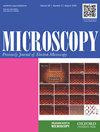用连续块面扫描电镜(sgf - sem)观察大鼠肝细胞zio染色高尔基体的全细胞变化
IF 1.9
4区 工程技术
Q3 MICROSCOPY
引用次数: 0
摘要
摘要高尔基体在各种生物合成途径中发挥作用,通常在电子显微镜下通过片层的形态学标准来鉴定。用连续块面扫描电子显微镜(SBF-SEM)进行三维分析,这是一种能够在全细胞水平上获得大量数据的体积SEM,可能是了解高尔基体精确分布和复杂超微结构的一种很有前途的技术,尽管这种分析的最佳方法仍然不清楚,因为观察可能会受到样本充电和低图像对比度的阻碍,并且手动分割通常需要大量人力。本研究首次尝试通过ZIO染色(一种经典的锇浸渍),通过SBF-SEM对大鼠肝细胞中的高尔基体进行全细胞观察和半自动分类和分割。染色电子致密地观察到单个高尔基体片层,其超微结构可以稳定地观察到,没有任何明显的电荷。序列图像的简单阈值化使得能够有效地重建标记的高尔基体,其揭示了一个肝细胞中的多个高尔基体。锌的基于重金属的组织化学的组合,碘和锇(ZIO)染色和SBF-SEM在整个细胞水平上对高尔基体的三维观察是有用的,因为有两个技术优势:(i)在没有任何重金属染色的情况下对高尔基物进行可视化,并且在没有额外的导电染色或任何用于消除充电的装置的情况下有效地获取块面图像;(ii)易于识别染色,并且通过图像的简单阈值进行无障碍的半自动分类和分割。这种新方法可以阐明肝细胞中高尔基体的地形特征。本文章由计算机程序翻译,如有差异,请以英文原文为准。
Whole-cell observation of ZIO-stained Golgi apparatus in rat hepatocytes with serial block-face scanning electron microscope, SBF-SEM
Abstract The Golgi apparatus, which plays a role in various biosynthetic pathways, is usually identified in electron microscopy by the morphological criteria of lamellae. A 3-dimensional analyses with serial block-face scanning electron microscope (SBF-SEM), a volume-SEM proficient in obtaining large volumes of data at the whole-cell level, could be a promising technique for understanding the precise distribution and complex ultrastructure of Golgi apparatus, although optimal methods for such analyses remain unclear since the observation can be hampered with sample charging and low image contrast, and manual segmentation often requires significant manpower. The present study attempted the whole-cell observation and semi-automatic classification and segmentation of the Golgi apparatus in rat hepatocytes for the first time by SBF-SEM via ZIO staining, a classical osmium impregnation. The staining electron-densely visualized individual Golgi lamellae, and their ultrastructure could stably be observed without any noticeable charging. The simple thresholding of the serial images enabled the efficient reconstruction of the labeled Golgi apparatus, which revealed plural Golgi apparatus in one hepatocyte. The combination of the heavy metal-based histochemistry of zinc, iodine and osmium (ZIO) staining and SBF-SEM was useful in the 3-dimensional observation of the Golgi apparatus at the whole-cell level because of two technical advantages: (i) visualization of the Golgi apparatus without any heavy metal staining and efficient acquisition of the block-face images without additional conductive staining or any devices for eliminating charging; (ii) easy identification of the staining and hassle-free, semi-automatic classification and segmentation by simple thresholding of the images. This novel approach could elucidate the topographic characteristics of the Golgi apparatus in hepatocytes.
求助全文
通过发布文献求助,成功后即可免费获取论文全文。
去求助
来源期刊

Microscopy
Physics and Astronomy-Instrumentation
CiteScore
3.30
自引率
11.10%
发文量
76
期刊介绍:
Microscopy, previously Journal of Electron Microscopy, promotes research combined with any type of microscopy techniques, applied in life and material sciences. Microscopy is the official journal of the Japanese Society of Microscopy.
 求助内容:
求助内容: 应助结果提醒方式:
应助结果提醒方式:


